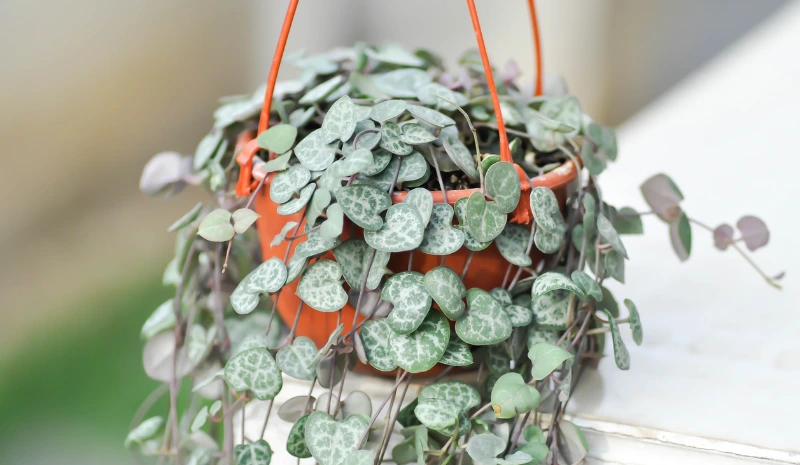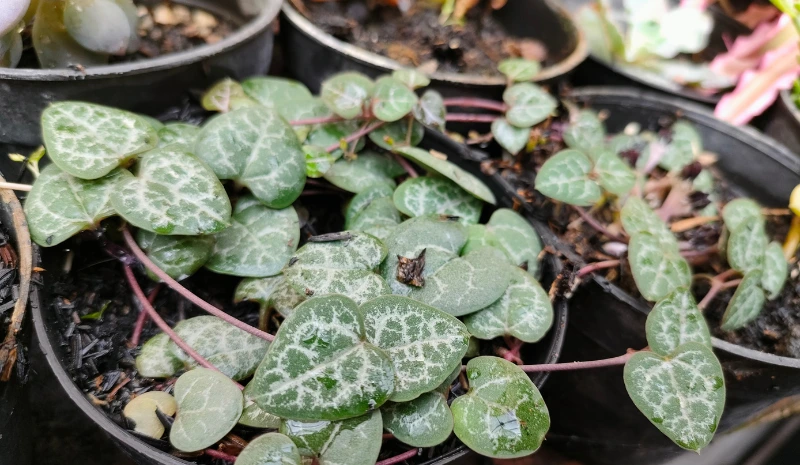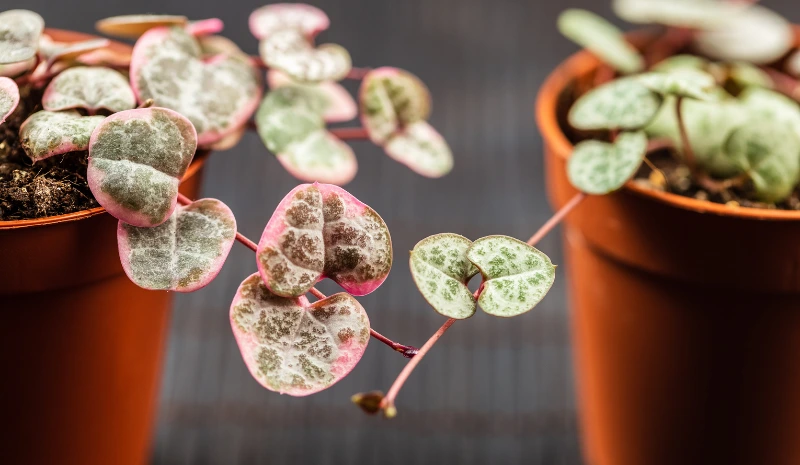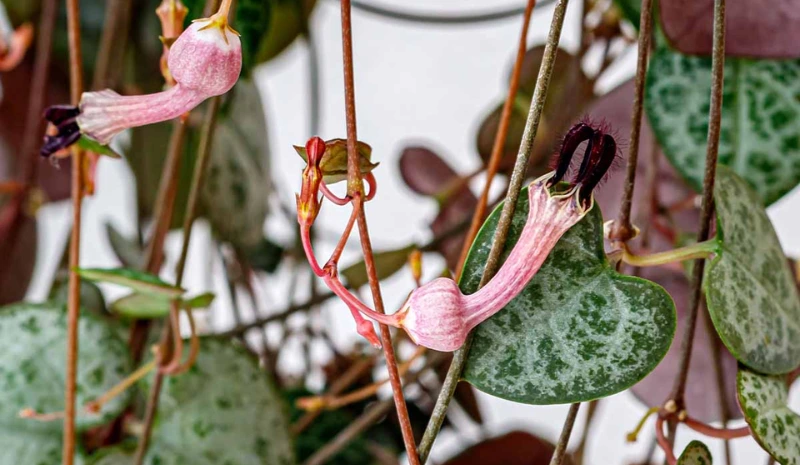If you adore trailing plants with a touch of elegance, the String of Hearts is an absolute must-have! With its delicate, cascading vines and charming heart-shaped leaves, this plant adds a whimsical touch to any space—whether spilling from a hanging basket, draping over a shelf, or basking in a sunny windowsill.
The good news? String of Hearts (Ceropegia woodii) is actually one of the easiest indoor plants to maintain—if you know the right tricks.
In this guide, I’ll share everything you need to know about String of Hearts plant care, from the best light conditions to watering schedules, soil preferences, propagation methods, and even how to prevent common problems like root rot. Let’s dive in!

What are String of Hearts?
The String of Hearts (Ceropegia woodii) is an absolute gem for plant lovers! With its delicate, trailing vines and adorable heart-shaped leaves, it’s the perfect blend of beauty and easy care. Whether you let it spill over the edge of a hanging basket, drape from a high shelf, or cozy up on a sunny windowsill, this plant brings effortless charm to any space.
Native to South Africa, the String of Hearts thrives in warm, tropical climates, but indoors, it’s happiest basking in bright, indirect light—ideally from a west- or south-facing window. If you’re lucky enough to live in a Mediterranean climate, you might even see it tumbling down walls or spreading as a ground cover in rock gardens.
Its leaves are a stunning gray-green with marbled patterns, and the delicate, thread-like vines take on a beautiful purplish hue. Give it a little trim now and then to encourage bushier growth, and watch it flourish! Left unpruned, these vines can cascade up to 12 feet long—a true showstopper in any plant collection.
Key Features
Botanical Name: Ceropegia woodii [1]
Common Names: Chain of Hearts, Rosary Vine, Hearts-on-a-String
Growth Habit: Trailing, vining succulent-like plant
Native To: South Africa
Difficulty Level: Easy to Moderate
Light Preference: Thrives in bright, indirect light, preferably from a west- or south-facing window for optimal growth and vibrant colors.
Watering Needs: Prefers a “soak and dry” approach—water thoroughly, then allow the soil to dry out completely before watering again. Overwatering is its biggest enemy!
Growth Rate: A fast grower, especially in warm conditions. Prune occasionally to encourage bushier growth.
With its delicate, heart-shaped leaves cascading down like a waterfall, String of Hearts makes for an amazing hanging plant or can be displayed on a shelf where its vines can drape beautifully.
How to Care for String of Hearts

Light Requirements
One of the most common reasons why a String of Hearts struggles is insufficient light. While this plant can tolerate lower light conditions, it truly thrives in bright, indirect light. Placing it near an east- or south-facing window is ideal, as this ensures it gets plenty of gentle sunlight without the risk of scorching. A few hours of direct morning sun can also promote stronger growth. If your home is on the darker side, a full-spectrum LED grow light can work wonders to keep your plant happy. However, avoid placing it in deep shade, where it may become leggy, or in harsh afternoon sun, which can burn its delicate leaves.
Watering
Overwatering is the number one cause of issues with String of Hearts. As a semi-succulent, this plant stores water in its thin, trailing vines and underground tubers, meaning it doesn’t need frequent watering. During the active growing season in spring and summer, water every 10–14 days, allowing the soil to dry out completely between waterings. In fall and winter, when growth slows, reduce watering to once a month or when the leaves begin to wrinkle slightly. Always check the soil before watering by sticking your finger about an inch deep—if it’s dry, it’s time to water.
Best Soil for String of Hearts
Good drainage is crucial for this plant, as soggy roots can quickly lead to rot. A well-draining soil mix will help prevent moisture retention and keep the roots healthy. The best mix consists of 50% cactus or succulent soil, 25% perlite for added drainage, and 25% orchid bark or sand to keep the soil light and airy. Avoid using standard moisture-retaining potting soil, as it holds too much water and can lead to root rot.
Temperature and Humidity
String of Hearts thrives in warm temperatures and does best in a range of 65–85°F (18–29°C). If temperatures drop below 50°F (10°C), growth may slow down, and the plant could struggle. Normal indoor humidity levels of 40–50% are perfectly fine, so there’s no need to mist this plant. In the winter, keep it away from cold drafts, open windows, or heating vents, as sudden temperature fluctuations can stress the plant.
Fertilizing
While the String of Hearts doesn’t require heavy feeding, a little boost during the growing season can help it flourish. Use a balanced liquid fertilizer diluted to half strength once a month in spring and summer. There’s no need to fertilize in fall and winter when the plant is dormant. Over-fertilizing can lead to weak, leggy growth, so it’s best to keep feeding minimal and consistent.
Pruning and Maintenance

If you want your String of Hearts to grow fuller and bushier, occasional pruning is key. Trimming long, leggy vines encourages new side growth and helps maintain a more compact appearance. Regularly remove any dead or yellowing leaves to keep the plant looking fresh and healthy. Don’t throw away the cuttings—this plant is incredibly easy to propagate, and with just a little effort, you can create new plants to expand your collection or share with friends.
How to Propagate String of Hearts
The best time to propagate, plant, or repot a String of Hearts is during the warmer months of spring, summer, or early fall. While growing this plant from seed is rare and often impractical, propagation through stem cuttings is quick, easy, and highly successful. With just a few simple steps, you can create new plants to expand your collection or share with friends.
To get started, take a healthy 3- to 4-inch cutting with at least two internodes using sterilized scissors or pruning shears. From there, you have three effective methods to root your cuttings:
Water Propagation
If you love watching roots grow, this method is for you! Using a clear jar filled with water makes it easy to monitor progress.
-
Remove the leaves from the bottom section of the cutting that will be submerged in water.
-
Place the cut end into the jar, ensuring the nodes remain underwater.
-
Keep the jar in bright, indirect light and change the water every 3–5 days with fresh, room-temperature water.
-
Once roots develop, transfer the cutting to a pot with moistened potting mix and care for it as usual.
Soil Layering
This method allows the plant to root while still attached to the parent vine, making it one of the easiest ways to propagate.
-
Lay a vine directly on top of the soil in a pot, ensuring that the growth nodes (small bumps along the stem) have direct contact with the soil.
-
Within two to eight weeks, roots will begin to sprout from the nodes.
-
To encourage faster rooting, lightly mist the soil and increase humidity by covering the area with plastic. Keep the plant in a warm spot with bright, indirect light.
-
Once the roots are well-developed, you can separate the new plant from the parent vine.
Direct Soil Planting
For a more hands-off approach, you can plant the cuttings directly into soil for fast, strong root development.
-
Dip the cut end of the cutting into rooting hormone to encourage faster growth.
-
Plant the cutting into a small pot filled with moistened, well-draining soil.
-
If your String of Hearts has tubers (small round growths on the stem), partially bury them in the soil, leaving some of the tuber exposed to the light—this will encourage new roots and fresh growth.
Potting and Repotting String of Hearts

String of Hearts is a vigorous grower under the right conditions and benefits from repotting every few years. While it can tolerate being slightly root-bound, repotting is necessary when roots start poking out of the drainage holes. The best time to repot is during the summer, when the plant is actively growing.
Since the vines are delicate and prone to breaking, handle them with care when moving the plant to a new pot. Choose a container with good drainage, preferably a terra-cotta pot, which helps excess moisture evaporate and prevents overwatering issues.
Overwintering
String of Hearts thrives in temperatures between 60°F and 80°F (16°C–27°C) but struggles in anything below 40°F (4°C). If exposed to cold temperatures for too long, the plant may decline or die. During the winter months, it naturally enters dormancy, so reduce watering and allow the soil to dry out more thoroughly between waterings. As spring arrives, gradually increase watering and reintroduce the plant to warmer conditions to encourage new growth.
Common Pests & Plant Diseases
Like many houseplants, String of Hearts can attract mealybugs, aphids, and scale insects. These sap-sucking pests can weaken the plant, causing wilting and overall poor health. If you notice an infestation, treat the plant with insecticidal soap, neem oil, or a strong spray of water (especially for aphids) to remove them.
Fungal infections and root rot are also common issues, often caused by excessive moisture and poor drainage. Black spots on the leaves may indicate a fungal problem. To prevent root rot, always use a well-draining soil mix and let the soil dry out completely between waterings. Proper care and monitoring will keep your String of Hearts thriving and pest-free!
How to Encourage String of Hearts to Bloom

When Does String of Hearts Bloom?
If you’re expecting big, dramatic flowers, the String of Hearts might not be the showiest bloomer. However, its small, delicate flowers have a unique charm. These blooms are about an inch long, with a tubular shape and a bulbous base, resembling tiny enclosed beads—one of the reasons this plant is also called the rosary vine.
The flowers are a soft magenta color and typically appear in late summer and fall, though under ideal conditions, they may bloom at other times of the year. While String of Hearts blooms more easily outdoors, it can be more challenging to achieve flowers indoors.
How to Encourage String of Hearts to Bloom
Getting your String of Hearts to bloom indoors requires the right care and conditions. To improve your chances:
-
Provide bright, indirect light—a west- or south-facing window is ideal.
-
Keep the plant healthy and stress-free by following proper watering and soil care.
-
Fertilize once a month in spring and summer with a balanced liquid fertilizer to encourage flowering.
Final Thoughts
Caring for a String of Hearts is easy once you understand its needs.
Just remember:
- Bright, indirect light is key
- Water sparingly (let the soil dry out!)
- Use well-draining soil
- Prune and propagate for fuller growth
Follow these simple tips, and your plant will reward you with long, trailing vines of heart-shaped beauty!
Got questions about your String of Hearts? Drop them in the comments—I’d love to help!
References
- ASPCA. “Nematanthus spp. (Goldfish Plant) Toxicity Information.” Accessed February 7, 2025. https://www.aspca.org/pet-care/animal-poison-control/toxic-and-non-toxic-plants/nematanthus-spp.
